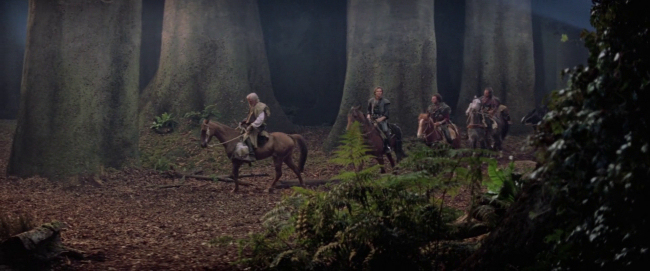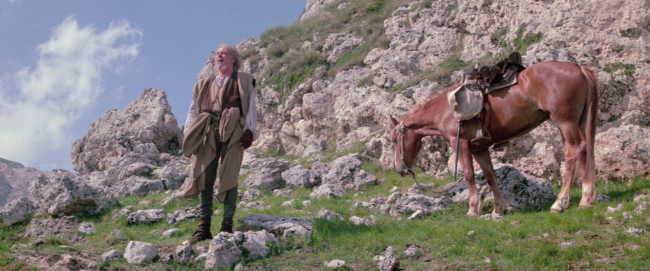
Cinematography isn't the only good thing about 1983's Krull but it is by far the best thing about the film. The real star of the film is cinematographer Peter Suschitzky and his expertly balanced colours in smooth shadows. The visual effects are tolerable, the performances are adequate, the story is obviously a deliberate attempt at minimalist fantasy that works out to be accidentally insubstantial. But, egad, is it pretty.

I could see the influence of Star Wars and The Hidden Fortress and, maybe more than anything else, the 1940 version of The Thief of Bagdad. Like that film, it has a king and princess who fall in love at first sight and have very few personality traits, the film involves the king's quest to save the princess, there's a scene where a supporting hero faces a giant spider on a huge web, and there's a scene involving a flying horse.

While I think the makers of The Thief of Bagdad did keep character complexity to a minimum on purpose, the characters still had more dimension than the two in Krull. In The Thief of Bagdad, Ahmad is a naive ruler whose overthrow is the beginning of a story that teaches him humility and empathy to temper his rashness. The princess is simpler--she's lonely and is charmed by Ahmad. Her opening song, the charm of the scenes she's in, and the momentum of the story make her work.
Krull doesn't even give its protagonists that much; Colwyn (Ken Marshall) and Lyssa (Lysette Anthony) meet at the beginning of the film for a marriage arranged by their families to unite two kingdoms. They barely have a conversation before the Slayers, an army of powerful aliens, show up, kidnap Lyssa, and kill everyone but Colwyn who's knocked out and somehow wakes up with barely a scratch.

He finds the Old One, played by former David Lynch regular Freddie Jones, is there when he wakes. The Old One is very much the film's Obi-Wan and he takes Colwyn to find the Glaive, this film's version of the lightsabre.

The Old One tells Colwyn not to use it until he really, really needs it but doesn't explain why. On their quest, they meet men who join them until they have a big, proper Dungeons and Dragons adventuring party. Even the comic relief, a magician called Ergo the Magnificent (David Battley), contributes to the film's visual power, his red pantaloons breaking up the general black, white, and green in the scene where he's introduced.

It's the Old One who faces the spider in what also turns out to be the film's most interesting moment of storytelling. At the centre of the web is a sorceress called The Widow of the Web (Francesca Annis). Her real name is also Lyssa, like the princess, and we learn that she and the Old One also used to be lovers. To escape the spider, she gives him the sand from her hour glass which protects him from the spider while it pours from his hand but will kill him when it runs out. The filmmakers are saying something about love and the importance of living life while you can, though I think what they're saying is simply, "Love is good and live life while you can."

Aside from telling us how great and wonderful marriage is in the climax, the only other prominent theme is fate, mainly manifested in an eerie cyclops character (Bernard Bresslaw) who's known the day of his death all his life.

Although the princess isn't developed even slightly as a character, her scenes where she wanders the evil castle and the beast tries to seduce her are among the film's most visually impressive.

A lot of the place looks like seashells with claws. Certainly it all looks very organic and perhaps there's something in it about a youthful anxiety about sex.

The film has Liam Neeson in a small role and a score by James Horner who, even for a composer who was known for borrowing from himself, borrows with surprising impunity from his own score for Star Trek II. Nothing is quite as amazing in this film as its photography.


No comments:
Post a Comment